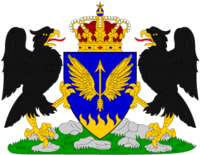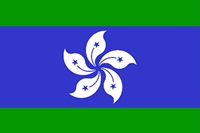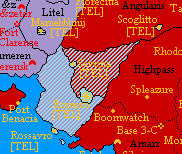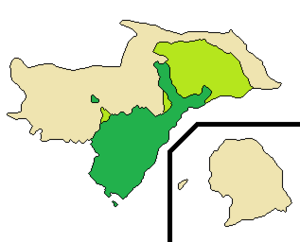Tellia
 | |
| Official language |
Gaian (official) English (administrative) |
|---|---|
| Capital | Romero |
| Largest cities | Fiorecittà |
| Website |
First Tellian Forum Second Tellian Forum |
| Forum | Current forum |
| Number of citizens | 6 |
| Number of active citizens | 2 |
| Date founded | IX.1534 AN |
| Government |
Constitutional monarchy (1535–1548) Confederation (1606–) |
| Current leader | Edoardo Sebastiani |
| Currency | Tellian Real (Telreal) |
| National animal | Eagle |
| National fruit/food | Pizza |
| National drink | Cappuccino |
 | |
| Map versions |
12.6–13.7.6, 15.3.1–18.0.0 |
Tellia, officially the Tellian Confederation, is a nation based in southern Benacia. Formerly an expansive kingdom which could trace its origins to the historical region of Gaia, the current government maintains precarious control over a small region analogous to the former Ashkenatzi Hither Tellia, two quasi-city-state enclaves and the autonomous Merenolitovina.
History
Foundation
The origins of the Kingdom of Tellia begin with the demise of the micronation of Gaia, formerly a CIS member state, by late 1534 AN. In IX.1534 AN, Hieu, the last president of Gaia, declared Tellia independent as a successor state to Gaia for the 'preservation of Gaian Latin culture'. The succession of Tellia was not without controversy, as the land it claimed was supposed to be roughly contingent with the old Gaian lands of the CIS on Eura. This was at a time when Babkha was gradually reclaiming land on Eura as the CIS was dying, and Tellian independence was seen by the Babkhans as a huge blow to their territorial ambitions for a resurrected Babkha on Micras, after returning to the MCS following the death of the GSO as a mapping organisation.
Hieu, known in Tellia as Dominico Amauri di Rossi, set Tellia on its course to independence, finally reaching a settlement with Babkha which allowed Tellia control of an island archipelago to the north of Eura. Ultimately, in 1535, Hieu passed leadership of the nation onto Chris Collins, a citizen of Tellia who would become the nation's king until its loss of independence. The precise nature of this transition of power is uncertain, though Hieu's involvement with a large number of other micronations at the time may have been an important factor.
Reign of Christopher I

Christopher I's reign began smoothly with many quick introductions of important legislation and a constitutional convention. Relations with Babkha were also important; this relationship becoming so close that Shahanshah Rashid Arsalani of Babkha presented to the King of Tellia the ceremonial command of three Babkhan divisions in 1534. By 1536, however, inactivity had taken its toll with Prime Minister Samantha Darling ousted in a vote of no confidence and replaced by Liam Reagan. Reagan's term would be an important one in terms of Tellian politics, as it was during this time that provincial governments in Tellia were established and granted extensive autonomy, as the Constitution of Tellia was finally completed.
Nevertheless, the king had been consolidating his own power and declared on IV.1536 that the Prime Minister was to be the 'servant of the King', and that the Interior, Military, and Foreign Ministers were to be directly appointed by the king. Tellia, proclaimed Christopher I, was 'not large enough for democracy'. This was not met with resistance and was in fact endorsed by Prime Minister Reagan, who saw the return to a form of monarchical autocracy as in the nation's best interests due to its low activity levels.
However, the Latinate culture of Tellia—inherited from Gaia—was popular with many, and Tellia saw eleven citizenship applications in its first two months of existence as an independent micronation. A new Tellian identity was forged, with an emphasis on the Tellian Church and the sanctity of the royal household. The state's official motto, Nostrum Placitum Locus ('Our Meeting Place' in Latin), was formalised along with the distinction of maintaining a very active micronational sports society courtesy of Hieu, the Federazione Gaianiano Giuoco Calcio, with its origins in the Gaian football league.

 Tellia's flag during its existence as a kingdom. Its unofficial usage continued throughout Ashkenatzi control.
Tellia's flag during its existence as a kingdom. Its unofficial usage continued throughout Ashkenatzi control.Tellian culture always remained deeply rooted in its Gaian past, however, with the name of the national language remaining Gaiano. This, over time, came be colloquially referred to simply as 'Tellian'. The national flag also signalled the Tellian passion for all things of Gaian heritage; identical to the flag of Gaia in every way save for darker shades of green and blue.
By 1538, Tellia had moved to a new forum and Reagan's administration had ended, with Will Tomsett becoming the first Grand Councillor, a position created to replace that of Prime Minister but altogether with less power. While various political groups manoeuvred for power at home, Tellia had been quietly developing relations with the Vanderveer Reich throughout the 1530s. Tellia had several times been denied ambitious claims to more Euran lands; expansions to the north and west had been planned for some time. Vanderveer, however, saw a flourish of activity and made several expansions which met with easy approval. Tellian activity levels struggled the late 1530s, even with political scandals rocking the nation regularly. Michael, Prince Regent of Vanderveer, along with Christopher I, King of Tellia, drafted 'The Treaty of Vanderveer and Tellia', and, after referendums passed in both nations, the treaty was signed in early 1539 AN.
Tellia existed as part of a new nation, entitled Vanderveer-Tellia, from the 1539 to 1541. The union was short-lived; tempers flared and the fight for power was a constant struggle between Tellians and Vanderveerens. The former king, Christopher, had been granted the position of Home Secretary. By 1540, however, he had moved for parliament to approve the dissolution of the union. Tensions flared during this period, and members of parliament were denounced as 'liars' by the former king. Personal disputes between the prince regent and Home Secretary made their way into the political battlefield. A technical issue was debated for several days after the motion for dissolution was made. According to the original treaty, two Tellian regions were granted half a vote each in the Vanderveeren Parliament. The claim was made that the dukes of these two regions had delegated their voting powers to Christopher. Michael, Prince Regent, made the argument that the dukes should return and cast their own votes. Eventually, yet another referendum was brought before the people, and a virtually unanimous decision was made to end the union.

As Tellia moved to Benacia from Eura and the Grand Council was formalised as the new legislative body, political tensions began to rise as Tellia's isolationism made enemies of Katyusha in 1542 and Hamland in 1543. These political disputes with other micronations led to a distinct move to the right in Tellian public opinion, and the recently established political parties represented this shift. Despite the foundation of the Tellian Liberal Party of Will Tomsett, the Conservative Party of former President Reagan and the king's own Liberation Party (founded to oppose communism) prevailed. The Tellian Communist Party was outlawed following the dispute with Katyusha, one of Micras' first communist nations for many years. At this time Tellia was also negotiating arms sales to Vanderveer for use in a possible war against the Republic of Antica. A bomb attack on the Monarchist National Convention in Romero in 1544 led to a heightening of the 'red scare' and Tellian isolationism reached new heights, though with this also came significant cultural development.
It was towards the end of 1545 when Tellia entered into negotiations with Amokolia and Ashkenatza in the Shirereithan-endorsed Central Benacian Relations Conference, founded to address concerns by the three nations over a large area of unclaimed territory in central Benacia, which Ashkenatza and Amokolia contested. Plans for a merger between the three nations at the conference were immediately rejected, and eventually a settlement was reached which divided the unclaimed lands equally between the three nations, with the city of Benaciastadt being divided into Ashkenatzi, Tellian, and Amokolian sectors. This agreement culminated in the Treaty of Romero, in which the three signatory nations also vowed never to go to war, and to co-operate with each other politically and economically. At this time, Tellia also enjoyed its first experiment with colonialism, claiming a small colony in southern Keltia.
By 1546, it was felt that isolationism and austerity were at an end, and Christopher I, worried at the lack of activity in the nation, announced a plan to reinvigorate Tellian politics, scheduling elections for Prime Minister for III.1548. It is believed that this was part of a plan to re-introduce a Constitutional Monarchy to Tellia, but the peace of the Treaty of Romero was to not last long and these hopes were never realised.
Annexation and legacy

In an move of aggression against Ashkenatza and return to isolationism, King Christopher I ordered all Ashkenatzi citizens to leave Tellian soil by II.1548, also suspending voting privileges for Tellian citizens of Ashkenatzi descent, and forbidding them to leave their province of residence. Ashkenatza, by now far more interventionist due to its 'Yiddishkeyt Doctrine', viewed this as a casus belli and occupied the Tellian sector of Benaciastadt on VI.1548. Some Tellian citizens also felt that the king's actions had created an existential threat to Tellia, such as firebrand politician Gjorgio Hjunson, who declared himself Provisional Chairman of the Council to try and restore law and order to Tellia.
A short and bloody war, known as the Ashkenatzi-Tellian War of 1548, led to Ashkenatzi forces invading Tellia and occupying the territories subsequently known as South Litovina and Merenia as Tellian forces mobilised in response. By VII.1548, Tellia capitulated and signed the Treaty of Klymenburg with Ashkenatza on that date, ceding all territory and sovereignty to Ashkenatza, whilst Babkha was granted a port in former southern Tellia in exchange for their military aid to Ashkenatza. King Christopher I remained in his estate in Romero, renamed Romersk, and Tellia was reduced to two Ashkenatzi provinces—Thither and Hither Tellia—whilst many of Tellia's peripheral regions became Ashkenatzi provinces under different names. Christopher I later became a prominent Ashkenatzi citizen, under the name Chaim Wajnstein, even leading the nation as Nohsi for one term, yet always remained committed to Tellian culture in Ashkenatza, where it underwent significant development. A brief attempt by Wajnstein at restoring Tellian independence in 1559 was ignored by Ashkenatzim and Tellians alike, and former Tellian provinces remained integral divisions of the Republic of Ashkenatza.
Tellians in Ashkenatza constituted the nation's largest minority, and the 'Tellian Question' featured heavily in later Ashkenatzi politics. Attempts to create a Tellian autonomous region were rejected by the Ashkenatzi Knesset, due to the assimilation of Tellians into Ashkenatza; with one legislator pointing out that there were, by 1560, more ethnic Tellians in the Ashkenatzi capital of Kolmenitzkiy than in the former Tellian capital of Romero. Tellians in Ashkenatza continued to be one of the most influential ethnic groups in the republic, with their own divisional units in the armed forces and, in 1567, the first ethnically Tellian Nohsi of Ashkenatza, Bartholomeo Henzelli, being sworn in to lead the nation.
Tellian integration evolved into a key factor of Ashkenatzi society following Henzelli's initial term as Nohsi, with a second term following in 1576, and the election of a further ethnic Tellian Nohsi in 1588 in independent Leon Gambetta. A notable absence of civil unrest, which had previously been commonplace in the first two years of annexation, in the Tellian territories during this time was praised in the Knesset as well as being highlighted as a positive result of Maroonism. This period became of one Ashkenatza's most developmentally productive, with any expectation that Tellia's future lay outside of its increasing Ashkenatzi homogenisation at an all-time low due to the nation's stability.
Unpredictable instability in Ashkenatza followed, however, in 1602. The fall of Kolmenitzkiy and subsequent collapse of the Republic of Ashkenatza as a whole came with little warning, and to this day cannot be completely explained by political analysts or historians. During the nation's final months of existence before complete capitulation, a rise in anti-Ashkenatzi sentiment and pro-Tellian protest began to develop in stronghold cities in Tellian-majority regions such as Romero, Savona and Scoglitto; as the Ashkenatzi state was crumbling, a new Tellian political structure was being formed with the aim of establishing a new, independent nation.
Return to independence

Ashkenatza's demise was ultimately confirmed on VII.1605, prior to the newly-founded Tellian Confederation officially establishing its initial claims in 1607. The post-Ashkenatza incarnation of an independent Tellia was led and shaped by its original founder, Hieu; a fact which forged a return to a more nationalistic government and emphasis on Latinate culture. Despite initial attempts to assert control over a contiguous territory roughly aligned to the borders of the former Hither Tellia region, a lack of immediate activity after declaring independence meant that Tellian claims were limited to six enclaves surrounding the cities of Romero, Savona, Fiorecittà, Scoglitto, Rossavro, and the Ashkenatzi-majority Mamehblinij; organised as the dependent territory of Merenolitovina.
Hieu, as president under the name of Marco Pittori, maintained Tellia's minimal claims on Benacia for just less than a year before quietly departing the nation—and entering a hiatus from the wider community—in 1617. The subsequent inactivity after Hieu's departure saw Tellia forfeit its MCS membership in 1623, which caused a national emergency and a successful coup d'état led by fluctuating citizens V.V. Fabbri and Giuseppe Fossone's 'Tellian Transitional Government'. The co-presidents' transitional administration was able to re-establish Tellia's former claims—barring the city of Scoglitto, which had fallen to Shireroth—in 1625, whilst withstanding attempts by Francesco Rinaldi to create a new 'Holy Serene Republic' Tellian state, which would favour the maintenance of the city enclaves over an ultimate goal of Tellian reunification, in 1629.
In 1632, Fabbri opened talks with Shireroth and Minarboria which would form the basis of the Treaty of Gloomburg, a document set to establish condominium regions around the southern-most enclaves under the shared control of all three signatories for the strengthening of Tellian infrastructure. The treaty's proposals, however, were unsuccessful in being recognised by the MCS, and the lands were instead divided solely between respective Shirerithian and Minarborian governance.

For approximately 18 years AN, the political situation in the greater Tellian region remained largely stable, until the prolonged collapse of the Minarborian government in 1650 allowed for Shireroth to establish control over further swathes of southern Benacia; surrounding the Tellian enclaves entirely and forming the Mandate of Tellia across the regions formerly agreed as condominiums in the Treaty of Gloomburg. Sustained stability again followed, with relations between the Confederation and the governorship of the Mandate notably positive—marked by activity and development throughout the greater Tellian society remaining at low but adequate levels—before a sequence of events now known as the Kalirion Fracture ignited a new stage in Tellia's history.
Recouping the heartland
Geography

At its full extent, the Kingdom of Tellia's claims stretched across a wide range of south-central Benacian terrain. Southern Tellia housed a notable stretch of coastline along the Cosimo Sea, along which lay regions of low-lying, arable land. Further inland, Tellia lay claim to regions of considerable highland, including the western reaches of the Crestfall Mountain range which forms the backbone of the continent. The highest point within Tellia's former lands was Mount Medivh; a mountain which remained under Tellian-majority jurisdiction within Thither Tellia during Ashkenatza's occupancy of the land.
After becoming part of Ashkenatza, the land universally recognised as Tellian was reduced significantly, though retained its lowland and highland split, with Hither Tellia—roughly equating to the populous areas of the division of Rex Leonia—covering the majority of the former, and Thither Tellia the latter.
Since the nation's return to independence and considerable limiting of its claims, Tellia's geography has primarily been restricted to pockets of land spread around both the lowlands of southern Benacia and the highlands toward the centre of the continent. Fiorecittà and Scoglitto are now the only stronghold settlements located in the range of the Crestfall Mountains, while Rossavro is Tellia's only developed remnant of its once expansive coastline.
Demographics
Despite its history of influence from foreign powers, Tellia has remained predominantly ethnically Gaian. Gaians constitute the largest group of what are considered to be the "Tellian people", and are a Latinate people of Euran descent from the original CIS state. Tellians may also trace their ethnic makeup to the neighbouring Cisamarrese people of Amarr, Shireroth, whose language is mutually intelligible with Gaian and have a vast recorded history of migration to and from the Kingdom of Tellia following its relocation. As a result, the Cisamarrese are rarely considered as foreigners within Tellia.
Currently, the nation's largest ethnic minorities are from those nations with which Tellia has had its longest political relations. Ashkenatzis are the most notable minority, due to Ashkenatza's lengthy period of control over Tellia, with the city of Mamehblinij housing a considerable majority and being governed as such, with all current Confederation-owned enclaves having Yiddish-speaking populations and Jewish quarters. Following the establishment of the Tellian Mandate, Shirerithians have become an increasing percentage of Tellia's population, and languages such as Passikaans and Sani are not infrequently heard spoken. The city of Rossavro maintains a strong Babkhi presence having been jointly-administered by Babkha during Ashkenatza's lifetime.
Politics
Tellia's political landscape has varied much through its past, in most part due to its independent history as both a kingdom and a republic, and its time a dependent region of another nation, as well as its succession from Gaia to Tellia. While Tellia's transitional government in effect abolished a political party setup in the nation, a restoration of the parliamentary system and parties from the period of the Kingdom of Tellia occurred in the mid-1670s AN.
Heads of state
Due to its tumultuous past, Tellia has witnessed a number of changes to its head of state, even since its days as Gaia. Where possible, this list also includes the names of any known, separate, heads of government. Individual Gregorian dates are listed where possible, otherwise just the month and year are shown. The running tally includes all officially recognised heads of state of both Gaia and Tellia.
- Gaia
- From 1510 to 1534 AN.
| # | Leadership | Name | Position | Heads of government |
|---|---|---|---|---|
| 1 | 1510 – 1514 AN | Zayd Al-Ani | President of Gaia[1] | |
| 2 | 1514 – 1517 AN | Natalie I | Queen of Gaia[2] | James Williams (Prime Minister) |
| 3 | 1517 – 1524 AN | Matheio Tioluzzi | President of Gaia[3] | |
| 4 | 1518 – 1524 AN | Jeremy I | King of New Brittania[4] | |
| — | 1519 AN[5] | William | Prince of New Brittania | Sir Dashing Daniel (Governor) |
| 5 | 1524 – 1527 AN | Hiếu Chí Tương | President of Amoria[6] | |
| 6 | 1527 – 1534 AN | Dominico Amauri di Rossi | President of Gaia[7] | Lucà Peremino (Prime Minister, 1530–1534) |
- ^ 1 Head of state of the CIS-aligned Independent Micronation of Gaia.
- ^ 2 Head of state of the CIS-aligned Kingdom of Gaia.
- ^ 3 Head of state of the CIS-aligned Republic of Gaia. Following the civil war and division of Gaia, Tioluzzi maintained as president of the CIS-aligned Republic of North Gaia and shared head of state duties.
- ^ 4 Head of state of the Kingdom of New Brittania. Following the civil war and division of Gaia, King of New Brittania Jeremy I became head of state of the Kingdom of South Gaia and shared duties.
- ^ 5 Prince William was acting head of state of New Brittania in Jeremy I's absence.
- ^ 6 Head of state of the United States of Amoria, of which the Staticizzo Gaianiano was a founding state.
- ^ 7 Head of state of the CIS-aligned Republic of Gaia.
- Kingdom of Tellia
- From 1534 to 1548 AN.
| # | Leadership | Name | Position | Heads of government |
|---|---|---|---|---|
| — | 1534 – 1535 AN[8] | Dominico Amauri di Rossi | — | |
| 7 | 1535 – 1539 AN | Christopher I | King of Tellia | Samantha Darling (Prime Minister, 1535–1536) Liam Reagan (Prime Minister, 1536–1538) Will Tomsett (Grand Councillor, 1538–1539) |
| 8 | 1539 – 1541 AN | Michael I | Prince Regent of Vanderveer[9] | |
| 9 | 1541 – 1548 AN | Christopher I | King of Tellia |
- ^ 8 Di Rossi oversaw the transitional period between the abolition of the Republic of Gaia, of which he was the final president, and the coronation of the king of the Kingdom of Tellia despite no accepted head of state title.
- ^ 9 Michael I became King of Tellia upon signing the Treaty of Vanderveer and Tellia, but continued to use his primary title of Prince Regent of Vanderveer.
- Ashkenatza
- For a list of the 15 Ashkenatzi heads of state from 1548 to 1605 AN, see List of Nohsim.
- Tellian Confederation
- From 1606 AN to present.
| # | Leadership | Name | Position |
|---|---|---|---|
| 25 | 1606 – III.1625 AN | Marco Pittori | President of Tellia |
| 26 | III.1625 – VII.1674 AN | Vittorio Vllazërim Fabbri | Transitional Co-Presidents of Tellia |
| = | Giuseppe Fossone | ||
| 28 | VII.1674 – VII.1680 AN | Vittorio Vllazërim Fabbri | President of Tellia |
| 29 | VII.1680 – VII.1692 AN | Giuseppe Fossone Jr. | |
| 30 | VII.1692 – VII.1704 AN | Anna Basciano | |
| 31 | VII.1704 – XII.1707 AN[10] | Antonio Mizzi | |
| 32 | XII.1707 – XIV.1707 AN[11] | Giorgio Cassino | |
| 33 | XIV.1707 – VII.1710 AN | Eloisa Fanti | |
| 34 | VII.1710 AN – VII.1722 AN | Honoré di Scogli | |
| 35 | VII.1722 AN – VII.1728 AN | Eraldo Mantovani | |
| 36 | VII.1728 AN – VII.1740 AN | Estella del Giorno | |
| 37 | VII.1740 AN – | Edoardo Sebastiani |
- ^ 10 Antonio Mizzi died in office and was succeeded by his Vice President, Giorgio Cassino.
- ^ 11 Giorgio Cassino resigned as President following a conviction for fraud in relation to the Tellian match fixing scandal.